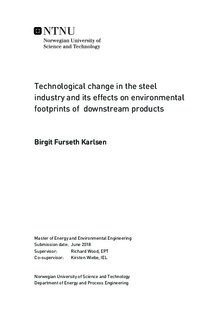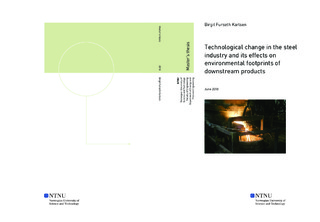| dc.description.abstract | The CO$_2$-emissions from the steel industry is at present 2.5 Gt, which represents 9\% of the worlds total carbon emissions in 2010. To keep the temperature change under 2.4\degree C compared to the pre-industrial time, a emission reduction of 50-85\% must be achieved in the industrial sector (Allwood et al. 2010).
The integrated blast furnace and basic oxygen furnace (BF/BOF) is the most emission-intensive of two steelmaking technologies, the other being the electric arc furnace (EAF). At present, the BF/BOF industry stands for 74\% of the total crude steel production (World Steel Association
2017).
Here, I show the possible global emission reduction in the future. This is done with two scenarios were the steel technology share shifts towards the EAF-route.
to correct the faulty emission-intensities of the technologies found in \cite{Karlsen2017}, a data re-allocation in the multi-regional supply-use tablewas carried out. The definition of the technologies can be altered in the use-table. Inn addition, re-allocation in the supply-table were done to adjust the technology shares.
Scenario 1: realistic depicts a realistic future leading the consumption-based CO$_2$-emissions from steel to decrease with 12\% compared to the current data. In scenario 2: BAT, a optimistic scenario were the EAF share is set to 75\%, the decrease is 33\% from the current data. The global decrease of total consumption-based CO$_2$-emissions was found to be 3-4\%. However, this is not sufficient to reach the climate goals.
The scenarios also showed a decrease in the share of the emissions and the total emissions, from steel in the other industries. The changes in percentage points were especially high in the manufacturing industries.
I therefor infer that if a bigger share of steel were made from the EAF-route, global emissions would decrease. However, more implementations and improvements of the already existing technologies must be utilised to fully realise the global emission reduction goal. | |

